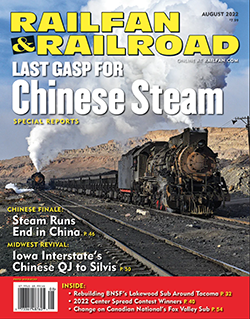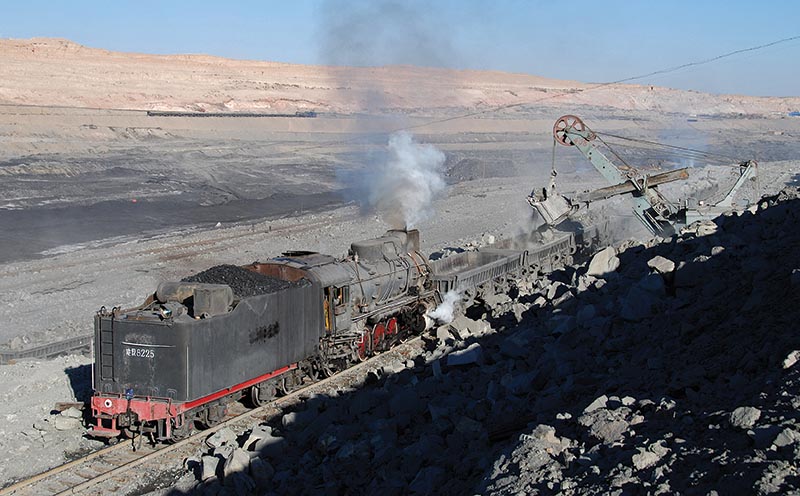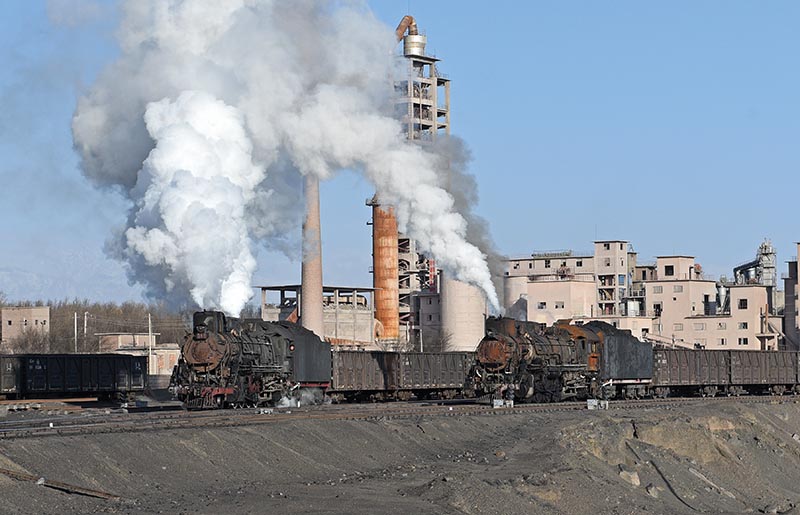 by Ben Kletzer/photos by the author
by Ben Kletzer/photos by the author
On April 25, 2022, the Sandaoling Coal Mine Railway ended regular steam service in its opencast pit coal mine in China’s Xinjiang Uyghur Autonomous Region, bringing down the curtain on regular line-service steam around the world. After more than 200 years of revenue steam operations in China, all that remains are part-time switching operations using steam as a backup for diesels.
The end of world steam marks the closing of a chapter of industrial history that started with Richard Trevithick in Georgian England, and the end of a way of life. Sandaoling was home to the last of the iron dinosaurs that battled the laws of physics to carry heavy cargo in revenue service. The steam railroaders at Sandaoling were the last of millions who lived and worked with freight-hauling steam.

ABOVE: Deep in the West Pit, an electric shovel loaded JS 8225’s spoil train while another JS navigated the switchbacks upgrade in the background.
Talking to the railroaders at Sandaoling, steam was practically in their blood; all grew up in the community, inheriting jobs from their parents before them. They brewed cups of tea on the footplate, steamed dumplings on the boiler, and worked tirelessly alongside the easily anthropomorphized machines. While the locomotives were filthy from their mining environment, the cabs were often spotless, with the crews taking time to polish the machinery and even decorating special locomotives for political and cultural occasions. The railroaders’ children were often spotted lineside, cheering as their parents coaxed another heavy coal train out of the pit. When the fires were dropped, this ended too, replaced by the thrum of trucks.
Sandaoling was born of China’s rush to industrialize as a socialist nation. The far western town lies on the ancient Silk Road and was uninhabited until a large coal deposit was discovered in 1958. The next year, the state dug an opencast pit coal mine and opened an 18-kilometer (11-mile) railway line to the China National Railways main line. Using antiquated European locomotives cast off from construction of the nearby Beijing-Urumqi main line, the mine railway developed into a massive system of more than 100 miles serving the open pit and underground mines.

ABOVE: On January 20, 2014, JS 8225 roared up the last 100 yards of the 2.5-plus percent grade out of the opencast pit and past Kengkouzhan. Soon the train would unload at the coal preparation plant and return for another load.
Sandaoling grew throughout the tumultuous Mao Zedong era, upgrading its fleet with former main line locomotives. When the first railfans visited the mine in the early 2000s, the fleet consisted of 54 2-8-2 locomotives all built in the 1980s. Much of the fleet was JS (Jianshe or “Construction”) class 2-8-2s, former main line freight engines built of a 1956 Sino-Soviet joint design. The large JS locomotives were supplemented by a few smaller SY (Shangyou or “Aiming Up”) 2-8-2s, a Chinese refinement of an American light Mikado. Completing the steam fleet was a group of steam cranes, built to American and Soviet designs, that laid temporary tracks in the pit and cleaned up wrecks on the line. Sandaoling was the last revenue user of steam cranes in the world, rostering two different models up to the end.
Keeping steam running in the 21st century was difficult, especially after the dieselization of Chinese main lines in 2005. Sandaoling responded by building an impressive workshop able to completely overhaul and rebuild its steam fleet. When I first visited in 2010, the railway used 27 locomotives serving three distinct operations — West Pit, East Pit, and South Station. Each operation was assigned a fleet of locomotives, with each terminal servicing its respective power…



